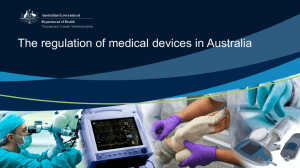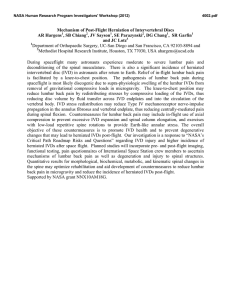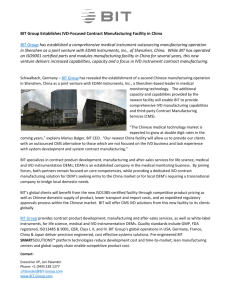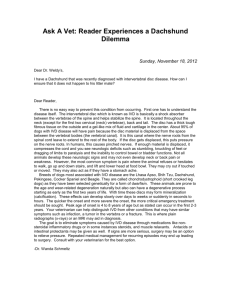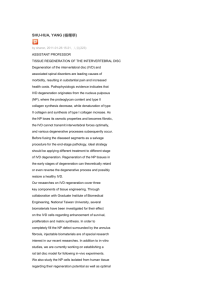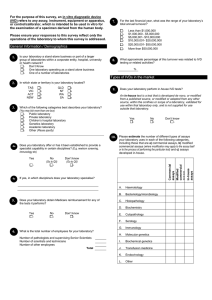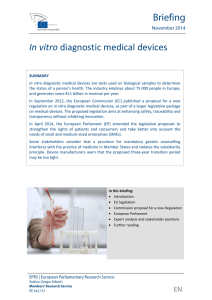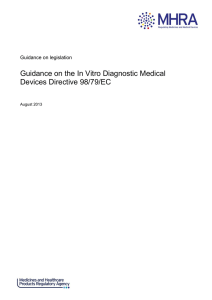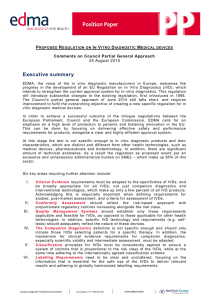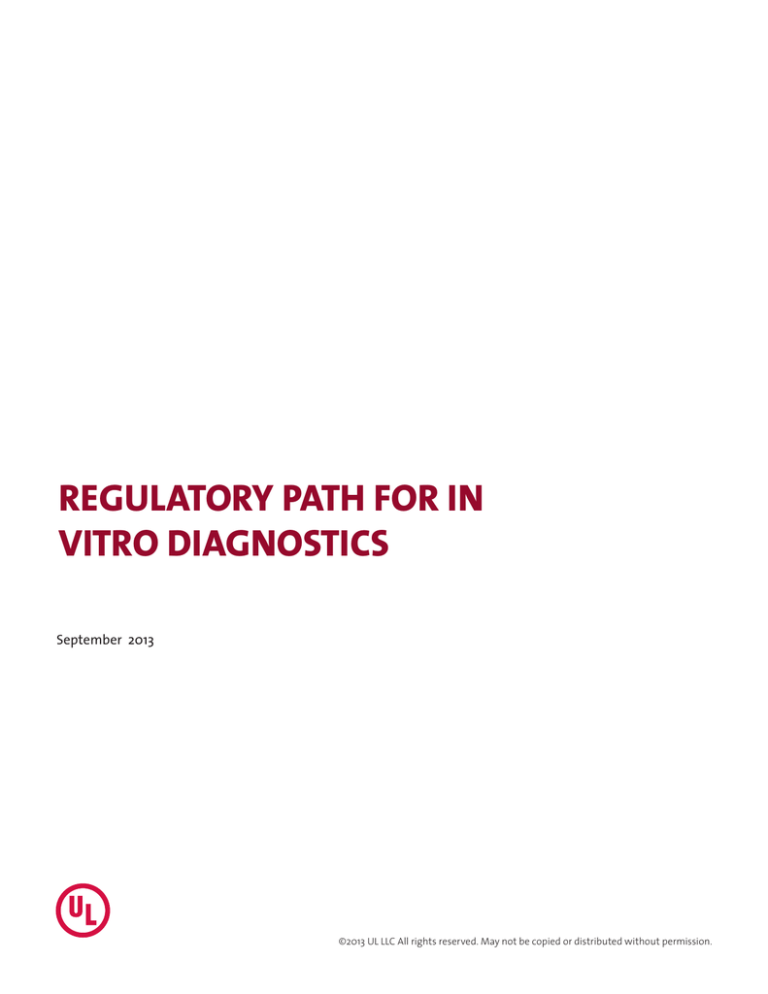
REGULATORY PATH FOR IN
VITRO DIAGNOSTICS
September 2013
©2013 UL LLC All rights reserved. May not be copied or distributed without permission.
REGULATORY PATH FOR IN VITRO DIAGNOSTICS
Introduction:
An in-vitro diagnostic (IVD) device usually comprises pathology tests and related instrumentation used to
conduct testing on human bodily fluids or tissue samples to assist in clinical diagnosis.
Regulatory and legal requirements applied to IVDs are set within the changing landscape. In the US, IVDs are
defined under 21 CFR 809 and are regulated under guidelines similar to medical devices. In the EU, IVDs are
defined and regulated separately from other medical devices under a separate IVD Directive 98/79/EC. IVDs
must comply with the essential requirements of Annex 1 of the directive and products must be CE marked to
be legally marketed in EU.
Classification:
Classification dictates the pre-market process and amount of regulatory oversight. The data required for
substantial claims has significant effects on the product development and marketing cost. The classification
of IVDs varies in both the EU and the US. In the US, IVDs are classified as other medical devices with the
regulatory control deemed necessary. Class 1 devices are under general control to provide reasonable
assurance of their safety and effectiveness. Most Class I devices are exempt from premarket notification.
Class 2 is under both general and special control. General controls alone are insufficient to provide reasonable
assurance of their safety and effectiveness and for which establishment of special controls can provide such
assurances. Special controls may include special labeling, mandatory performance standards, risk mitigation
measures identified in guidance, and post market surveillance. Class 3 devices require general and special
control with mandatory PMA approval.1
Table 1: FDA IVD classification
Classification
Class 1
Level of risk
low to moderate risk
Controls
general controls
Examples
• Complement reagent, phosphorus (inorganic) test
systems
• E. coli serological reagent
Class 2
moderate to high risk
general controls and
special controls
• Immunological test system
• Glucose test system
• Coagulation Instruments
Class 3
high risk
general controls and PMA
(premarket approval)
• Automated PAP smear readers
• Nucleic Acid Amplification devices for Tuberculosis
• Total prostate specific antigen (PSA) for the
detection of cancer
2
©2013 UL LLC All rights reserved. May not be copied or distributed without permission.
REGULATORY PATH FOR IN VITRO DIAGNOSTICS
In the EU, IVD devices are classified into four categories based on the risk and regulatory control. These
classifications are General, Self-test, Annex II List A and Annex II List B.
Table 2: EU IVD classification
Classification
General
Level of risk
Examples
Low Individual and Public Risk
• Specimen receptacle, a microbiological culture medium,
enzyme immunoassay analyser
• Tests for Hormones, Cardiac Markers, Hematology and
Clinical Chemistry Tests
Self-testing
Risk increased due to use by lay users
• Pregnancy self-test, Urine strip test, Hormone home test
Annex II List A
High Individual and Public Risk
• Reagents and reagent products, including related calibrators
and control materials, for determining the following blood
groups: ABO system, rhesus (C, c, D, E, e) anti-Kell
• Reagents for determination for the detection, confirmation
and quantification in human specimens of markers of HIV
infection (HIV 1 and 2), HTLV I and II, and hepatitis B, C and D,
Annex II List B
Moderate risk
• Tests for irregular anti-erythrocytic antibodies.
• Tests for rubella and toxoplasmosis
• Tests for phenylketonuria
• Tests for cytomegalovirus and chlamydia
• Tests for prostate-specific antigen
• Tests and software for evaluating risk of Trisomy 21
• Self-tests for blood sugar
Regulatory Pathway
Diverse paths for obtaining US FDA approval:
For the Class I devices that are the subject of the guidance document, FDA intends to propose an amendment
to the classification regulations to exempt these devices from 510(k) requirements that currently apply. While
FDA proposes and finalizes these down classifications and exemptions, it will exercise enforcement discretion
with regard to 510(k) submission requirements for the relevant devices.2
3
©2013 UL LLC All rights reserved. May not be copied or distributed without permission.
REGULATORY PATH FOR IN VITRO DIAGNOSTICS
The devices subject to enforcement discretion includes the following:
• Clinical chemistry devices, such as iron (non-heme) test systems, breath-alcohol test systems, and others;
• Hematology devices, such as platelet-adhesion tests, euglobulin lysis time tests, and others;
• Immunology and microbiology devices, which include hemoglobin immunological test systems.
For US Market approval, there are several factors other than classification that influence the process for
regulatory approvals (Figure 1).
• If the new test can be shown to be substantially equivalent to an existing device which is considered as
predicate device, then the 510(k) is the regulatory path for approval.
• If new diagnostic technology cannot be considered substantially equivalent to an existing technology,
and will be used to make a critical medical decision concerning the diagnosis, treatment, or medical
management, then the premarket approval (PMA) is the regulatory path of choice.
• If no predicate device exists and the test is of low or moderate risk, it may be eligible for a de novo
reclassification.
• If the test is done “in house,” in the designated laboratory only, for a patient sample that is sent to the
laboratory from an outside physician’s office or medical facility, then the test can be potentially marketed
under “home brew” guidelines (also known as laboratory developed tests) regulated under the Clinical
Laboratory Improvement Amendments (CLIA).
Figure 1: Regulatory Approval Process
Class 1
Class 2
Class 3
low risk
moderate risk
high risk
class 1
exempt
Traditional
510(k)
premarket
application
(pma)
Device needs to show equivalence to a
legally marketed predicate
510(K) review
90 days
fda
clearance
4
De novo
510(K)
No predicate
Device need to demonstrate
safety and effectiveness
Device needs
to
demonstrate
S&E
PMA review
180 days
fda
approval
©2013 UL LLC All rights reserved. May not be copied or distributed without permission.
REGULATORY PATH FOR IN VITRO DIAGNOSTICS
Clinical Laboratory Improvement Act 1988 (CLIA)
CLIA is an accreditation program under the US
regulations for clinical laboratories, to establish
“quality standards for all non-research laboratory
testing performed on specimens derived from
humans for the purpose of providing information
for the diagnosis, prevention, treatment of disease,
or impairment of, or assessment of health.”3
CLIA certification is based on three levels of test
complexity - waived, moderate and high.
Waived tests must be simple and have insignificant
risk of an erroneous result. Laboratories performing
only waived tests are subject to minimal regulation,
whilst moderate or high tests are governed by
proficiency testing, quality assurance, quality control
and inspections. IVD manufacturers should apply for
CLIA categorization during the pre-market process.
Point of care and self-test IVDs generally require a
CLIA waiver.
EU Conformity Assessment Procedure
To obtain a CE mark in the EU, the manufacturer
must ensure that the device meets the essential
requirements of the IVD Directive by following the
appropriate conformity assessment procedures
according to IVD classification. Notified Bodies (NB)
are licensed by the national regulators (Competent
Authorities) to perform conformity assessment of
medical devices including IVDs.
The manufacturer must register with one Competent
Authority in a Member State, preferably the state
where the place of business is registered. If the
manufacturer does not have a registered place of
business in a Member State and wish to place IVD
in the European market then they should designate
5
a person established in the community to act on
manufacturer’s behalf as Authorized Representative.
For IVDs in the general (self-certified) category, a
Declaration of Conformity can be prepared and
supporting evidence documented. There is no
Notified Body intervention but the products must be
registered with the Competent Authority. For general
IVDs the manufacturer self-declares conformity with
the relevant essential requirements of the Directive.
For self-test devices, there is a requirement for the
manufacturer to submit details of the device design
to an independent certification organization known
as a Notified Body. The Notified Body will assess the
design of the device in terms of its suitability for nonprofessional users. Alternatively, manufacturers can
opt to follow the routes for higher risk products.
IVDs for self-testing and those included in Annex II
List A and B need the intervention of a Notified Body
in the Conformity Assessment procedure before the
device may be CE-marked and placed on the market.
For moderate and high risk IVDs (AnnexII List A
and B), the manufacturer’s quality management
system must be fully audited by a Notified Body
to demonstrate conformity with the requirements
of the IVD Directive. For some products in List A
of Annex II “Common Technical Specifications”
(CTSs) have been developed to establish the
minimum performance requirements of the device.
Manufacturers must use CTSs, where established, to
demonstrate conformity with the Directive. 4 CTSs
define appropriate performance evaluation and
re-evaluation criteria, batch release criteria, reference
methods and reference materials. In addition,
products in List A of Annex II will require batch
release by the Notified Body.
©2013 UL LLC All rights reserved. May not be copied or distributed without permission.
REGULATORY PATH FOR IN VITRO DIAGNOSTICS
Performance Standard:
IVD performance is demonstrated through accuracy, repeatability, specificity, and sensitivity and defining
limits of detection/quantification (Figure 2).
Figure 2:
Determine
Level of Risk
• Test Measure
• Intended Target
Population
• Test results to be used
Device
Description
• Define all components
of test system
Analytical
Performance
Clinical
Performance
• Precision and accuracy
• Clinical cut off
• Linearity/reportable range
• Sensitivity/specificity
• Traceability
• Positive/negative
predictive value
• Stability
• LOD & LOQ
• Expected value/
reference interval
• Interferrence, cross reactivity
• Matrix and sample type
comparisons
Specific performance characteristics: Include, as appropriate, information such as accuracy, precision,
specificity, and sensitivity. These should be related to a generally accepted method using biological specimens
from normal and abnormal populations. Include a statement summarizing the data upon which the specific
performance characteristics are based.5 Performance objectives should clearly state what is being measured
and how this will be done. Performance end-points should be clearly linked to clinical claims and a statistical
hypothesis provided with supporting sample size calculations. As with all clinical investigations, endpoints
should be measurable, reproducible and standardized across investigational sites. Where a measurable
endpoint is not possible, bias should be minimized.
A minimum of three investigational sites should be used, with multiple operators and a setting that reflects
the intended setting for clinical use. Test operators should reflect intended users in terms of education and
experience. Day to day variability and operator variability should be taken into account when considering
intended sample type and testing matrix. Final versions of the device should be used according to the final
instructions for use.
6
©2013 UL LLC All rights reserved. May not be copied or distributed without permission.
REGULATORY PATH FOR IN VITRO DIAGNOSTICS
Software:
Software may be an accessory to an IVD and as such
be registered as an IVD in its own right. Standalone
software qualified as in vitro diagnostic medical
devices is regulated according to Directive
98/79/EC.6 Software that is specifically intended by
its manufacturer to be used together with an IVD
medical device to enable that device to be used in
accordance with its intended purpose falls under the
scope of the IVD Directive and shall be treated as an
IVD device in its own right. Examples: Analysis and
interpretation of the optical density delivered by an
ELISA reader, line or spot pattern of a blot.
About UL IVD Services
UL provides complete lifecycle services for IVD
manufacturers seeking global regulatory approvals.
We manage every facet of the global launch plan
throughout your development continuum, from
initial R&D and testing the product to conducting
validation studies and clinical studies to final
submission for low or medium to high risk IVD
products.
Anticipated changes in the upcoming
IVD Regulation:
An EU Regulation will replace the current Directive
79/98/EC, further encouraging a harmonized
single market for IVDs and replacing the patchwork
of national rules which transposed the IVD Directive.
The new Regulation will cover all devices that
are placed on the market from the moment it
is applicable.
7
The expected changes in the Regulation can be
divided into two areas: Firstly, ‘technical’, IVD-specific
areas which cover the essential requirements,
classification system, conformity assessment
procedures and clinical evidence requirements.
Secondly, features common to the medical devices
sector (IVDs as well as other medical devices) such
as the designation and monitoring of notified bodies,
vigilance and market surveillance and its governance
system.
A new classification system for devices is expected
which would ‘upgrade’ many devices to a higher
class of risk. The new Regulation is also likely to
tighten up conformity assessment procedures and
introduce new requirements for notified bodies. For
many manufacturers this means a more stringent,
time-intensive and costly set of requirements
impacting the design and manufacturing of devices.
Both new and already existing devices would need to
comply with the requirements.7
New clinical evidence requirements specific to the
IVD sector are also expected at the level of the way
a device works to provide a diagnosis. There would
be additional requirements for clinical evidence,
especially for new devices. This would help patients
and laboratories by making the work of laboratories
and health care professionals easier when selecting
new tests.
©2013 UL LLC All rights reserved. May not be copied or distributed without permission.
REGULATORY PATH FOR IN VITRO DIAGNOSTICS
References:
1.
21 CFR 860.7, Determination of safety and effectiveness, in Medical
Device Classification Procedures, found at http://www.accessdata.
fda.gov/scripts/cdrh/cfdocs/cfCFR/ShowCFR.cfm?FR=860.7.
2.
FDA To Exempt Some IVDs from 510(k) Clearance, IVD Technology,
Published: March/April 2012, Volume 18, No. 2.
3.
Centers for Medicare & Medicaid Services, Medicare Learning
Network, Clinical Laboratory Improvement Amendments (CLIA), ICN
#006270 May 2012 (http://www.ok.gov/health2/documents/MFS
%20CLIAbrochure.eff.05.2012.pdf)
4.
Sale and Supply of In Vitro Diagnostic Medical Devices, Sep
2011,MHRA, Bulletin 12
5.
http://www.gpo.gov/fdsys/pkg/CFR-2011-title21-vol8/pdf/CFR2011-title21-vol8-part809.pdf
6.
http://ec.europa.eu/health/medical-devices/files/meddev/2_1_6_
ol_en.pdf
7.
http://edma-ivd.eu/library/the-proposal-for-new-ivd-regulation#
Contributing Author: Divya Ganapathy, Technical Consultant – UL
Divya works for UL as a Technical Consultant in India. She has eight years of experience in Regulatory
Affairs, and specializes in U.S. FDA 510(k), EU CE Marking, Risk Management, Preclinical and Clinical
for Medical Device and IVDs and Biocompatibility Studies as per ISO 10993. She holds a master’s
degree in microbiology, bachelor’s degree in regulatory affairs and is a certified lead auditor for
ISO 13485. She is also trained in conducting FDA mock audits and GMP for the pharmaceutical and
medical device sectors.
This article is for general information purposes only and is not intended to
convey legal or other professional advice.
8
©2013 UL LLC All rights reserved. May not be copied or distributed without permission.

